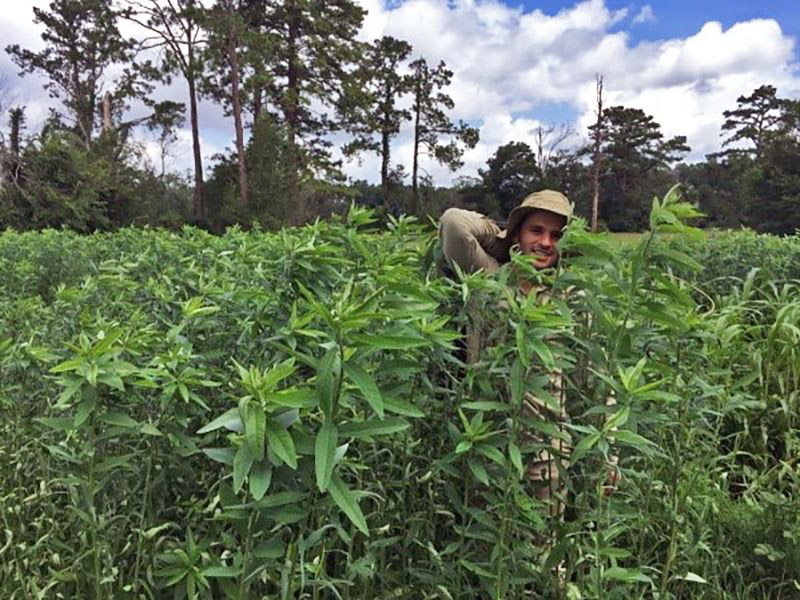-
International
With a presence in Asia, Africa, Australia and the Pacific, the Caribbean, and the United States; working with both small farmers and large enterprises we are never too far from your needs. -
-
TROPICAL SEEDS, LLC
2175 NW 24TH AVE.
MIAMI, FLORIDA 33142-7279
USA
Phone: +1 954 7536301
-
Sunn Hemp: A Fast Growing Annual Forage Legume
Jose Dubeux, João Vendramini, L. Garcia, D. Jaramillo, E. Santos, F. van Cleef, UF/IFAS Agronomy Department
Introduction

Figure 1. Sunn hemp trial at UF IFAS NFREC Marianna. Photo credit: Jose DubeuxWarm-season perennial grasses are the most used forages in Florida; however, nitrogen (N) fertilization is needed to maintain their productivity and nutritive value. Warm-season forage legumes can help to improve forage nutritive value and add N to the system via biological atmospheric N2 fixation. Sunn hemp (Crotalaria juncea L.) is a fast-growing warm-season annual legume native to India and Pakistan. It is adapted to tropical and subtropical regions in the world. Sunn hemp has previously been grown as a fiber crop, green manure, and cover crop (Wang et al., 2018). However, it may be a valuable source of forage for livestock.
Sunn hemp seeds have low concentration of the toxic pyrrolizidine alkaloid, therefore, it is not recommended to be fed to livestock after the seedpods are formed. It is important to note that in Florida, sunn hemp has low potential to set seeds due to inappropriate combination of temperature and day length. In South Florida it can make profuse flowers, but limited seed production (Wang et al., 2018). Sunn hemp foliage has not shown any sign of toxicity, and can be safely utilized by grazing livestock or fed as greenchop or conserved forage (Mosjidis et al., 2012). At early maturity, sunn hemp has sufficient crude protein concentration levels to meet the requirements of most livestock categories. In addition, the fixed N recycles back to the pasture via cattle excreta or litter, and becomes available for the companion grass, if grown in mixture.Approach
At UF IFAS NFREC Marianna we tested two sunn hemp varieties (Crescent Sun and Blue Leaf), under three seeding rates (15, 25, and 35 lbs/ac), and two inoculation levels (inoculated and non-inoculated). Treatments were allocated in a randomized complete block design, with four replications, and repeated for two consecutive years (2017 and 2018). We added two control treatments (browntop millet and Tifleaf-3 pearl millet) to use as reference plants to measure biological N2-fixation. Sunn hemp and reference plants were seeded in May 8, 2017 and May 24, 2018, using a no-till drill. Plots were fertilized in May 8, 2017 and June 8, 2018 with 300 lb/acre of 0-5-20. Harvested occurred on June 23, 2017 and July 17, 2018, at 10-cm ( 3.9 in) stubble height.

Figure 2. Sunn hemp 45 days after seeding at UF IFAS NFREC Marianna. Photo credit: Jose DubeuxResults
Crescent Sun was more productive and fixed more N than Blue Leaf, but it had lower nutritive value (Table 1). Both varieties had greater crude protein (CP) concentration (18%) than typically found in bahiagrass (8-10%), which will be important to improve cattle performance during the summer. Forage digestibility (IVOMD) varied from 53.1 (Crescent Sun) to 56.4% (Blue Leaf) and is in the range often found in tropical forages. Crescent Sun fixed 36 lb N/A during a short period, which is equivalent to 171 lb of ammonium sulfate, or 80 lb of urea per acre. In these results, we are not considering the below ground contribution from root and nodules decomposition, which would increase sunn hemp N contribution to the system.

Seeding rate affected herbage accumulation but it did not affect sunn hemp nutritive value or biological N2 fixation (Table 2). Greater seeding rate (35 lb/A) resulted in greater herbage accumulation compared with the intermediate seeding rate (25 lb/A), but similar to the lowest seeding rate (15 lb/A). Plants compensate tiller weight according to planting density, with heavier tillers often occurring in less dense plant populations. This mechanism of compensation likely explains the results observed for seeding rate. Seed inoculation affected CP and herbage accumulation but did not affect digestibility (IVOMD) and biological nitrogen fixation (BNF) (Table 3).


Take Home Message
Sunn hemp is an annual warm-season legume that is able to produce forage biomass in 45-60 days of growth in Florida. As a forage, sunn hemp may have greater crude protein than perennial warm-season grass such as bahiagrass or bermudagrass, and it might help to promote livestock gains during the summer. In addition, sunn hemp fixes atmospheric nitrogen (N) that is recycled back to the system and might be used by companion grasses, reducing the need for N fertilization. If managed properly, sunn hemp may be an additional option for FL livestock producers.
References
Mosjidis, J.A., J.M. Burke, and J.B. Hess. 2012. The facts about sunn hemp toxicity. Crop Sci. 52:1469-1474.
Wang, Q., Y. Li, W. Klassen, and E.A. Hanlon Jr. 2018. Sunn Hemp – A promising cover crop in Florida. EDIS SL-306
Article taken from: http://nwdistrict.ifas.ufl.edu/phag/2019/05/03/sunnhemp-a-fast-growing-forage-legume-worth-consideration/
-
-
TROPICAL SEEDS, LLC
2175 NW 24TH AVE.
MIAMI, FLORIDA 33142-7279
USA
Phone: +1 954 7536301




